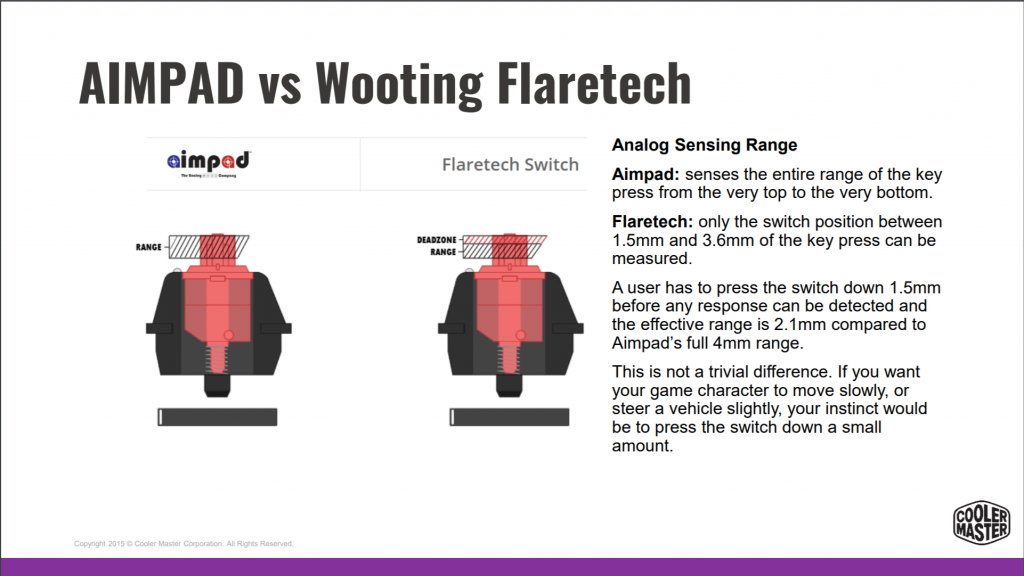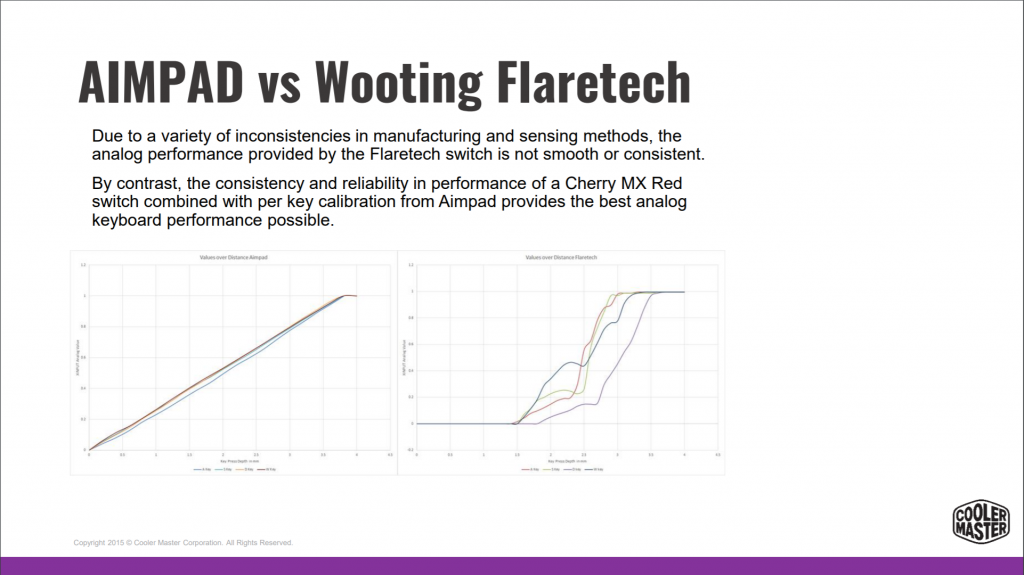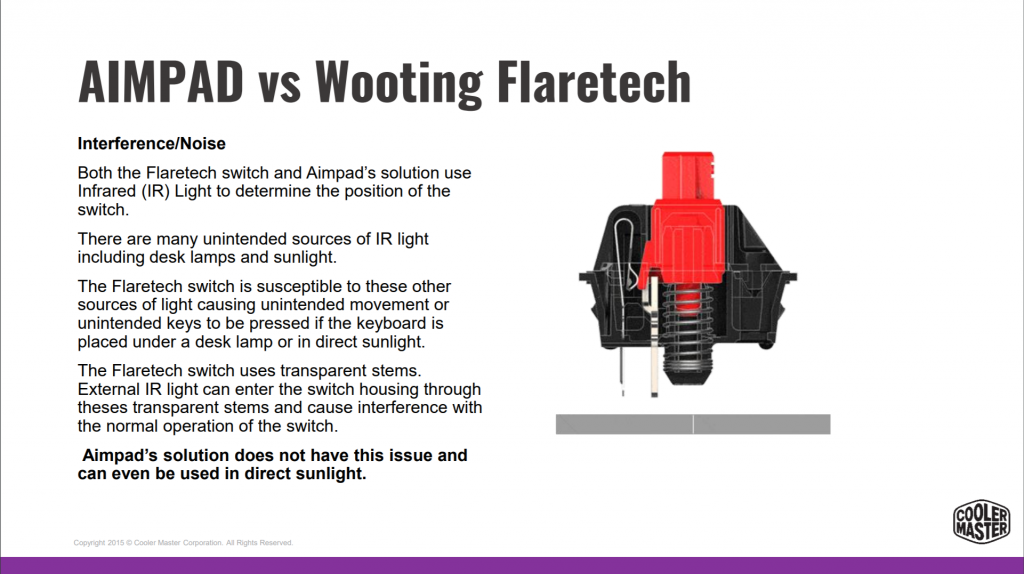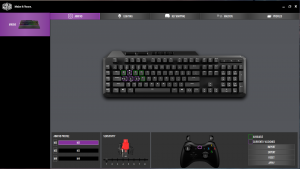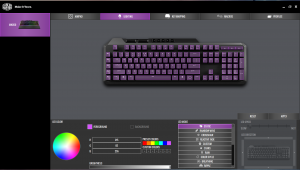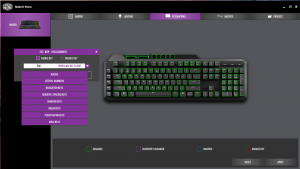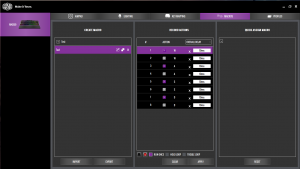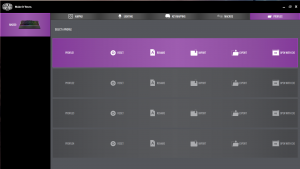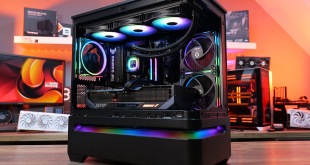Aimpad technology:
Aimpad technology can measure how far a mechanical switch is pressed using an infrared LED. The amount of light detected by the sensor depends on how far the key is pressed. The higher the key the less light is reflected, and the closer the key to the sensor the more light is reflected. A clever bit of coding later and the amount of pressure you use on that switch with your finger tells the game how fast you want to go, just as if you were using the joystick or triggers on a controller.
If you are a gamer this is a huge advantage over the typical all or nothing approach from a standard mechanical switch. Aimpad technology on the MK850 is only used with specific keys, but it is the keys that make the most sense for gamers: WASD & QERF.
Cooler Master has set up 5 preset profiles which can be switched between using the five M profile keys located on the left hand side of the keyboard. A button on the top right hand side of the keyboard is used to toggle Aimpad on or off, and once the keyboard flicks on and off it is ready to go.
- M1 is the basic keyboard mode used for typing but Aimpad still runs in the background
- M2 is the FPS Profile where Aimpad is enabled for the WASD keys, which function like the left stick of a controller
- M3 is the driving or flying profile where Aimpad is enabled for the WASD keys with the W and S keys functioning as the Left and Right analogue triggers of a controller
- M4 is the Advanced flying profile where WASD will function like the left analog stick and Q and E will function as the Right and Left triggers
The way Cooler Master has set it up is great as it essentially makes this keyboard very ‘plug and play' friendly with any game that has controller compatibility. The game simply detects that part of the keyboard as an Xbox controller and there’s pretty much no set up required before you jump straight into a game.
The Aimpad technology is of course also customisable. On the keyboard, next to the button to completely turn Aimpad off, you have 2 buttons to increase or decrease the sensitivity. What I didn't like about these is when adjusted there is no indication as to what level is selected which can mean it is very much a case of trial and error. I found out that sometimes key presses were barely registering when it was too low, or keys were falsely registered when it was too high. Thankfully the keyboard has an inbuilt calibration mode that's quick and easy and works to get Aimpad working properly again.
Changing the sensitivity on the keyboard should really show up in the software to give users an accurate indication of the current sensitivity level. When it comes to the software, too, I do wish there was a little more customisation as changing the sensitivity seems to affect all of the profiles and not just the one that's selected. I’d also like to change the sensitivity for the keys individually, so steering sensitivity could be separate from the throttle for instance.
You can, however, customise 3 out of the 4 Aimpad profiles using the software to rebind the keys for different scenarios. Teamed with the 4 keyboard profiles this means you can have up to 12 different Aimpad settings.
Using Aimpad:
Using the Aimpad technology really does take some getting used to. Even though the keyboard is easy to set up I found reprogramming years and years of muscle memory to be much more difficult. We are all used to tapping at our keyboards to get the required movement in various games and I found this to be a very hard habit to break and it is still something I have to consciously think about. However, when using the Aimpad technology to its full potential, the difference in games is immediately noticeable.
Opening Forza and sitting down in front of my monitor to play with a keyboard and mouse felt oh so wrong, but I must admit I was pleasantly surprised. With a bit of practice you can control the speed of the car and turn slowly or hard. It’s surprisingly smooth, although I do still prefer my controller. In CS:GO you have way more options when it comes to pace. I'd never played it on a console with a controller before before but you can do more than just a flat out run or hold shift to walk. You can gradually pick up pace or peek around a corner with more precision utilising the different movement speeds.
Turning the keyboard to the M5 profile where the actuation distance is tiny means that you can barely breathe on a key and it has already registered in game. This was perfect for getting an advantage in a MOBA like League of Legends as I certainly need all the help I can get when it comes to reaction times!
One of the games that made the most sense to try with this keyboard was GTA 5. It has aspects from shooting, driving and flying and I'm sure other games like Far Cry and PUBG would also work well. Driving and flying in game is better with a controller, but you have a big advantage to aim and shoot with a mouse. The MK850 does give you the best of both worlds.
However, when I jumped into a plane I noticed an issue with this keyboard and that in GTA flying a plane requires not only the triggers of a controller but also the bumpers. For some reason Cooler Master has omitted quite a few keys from the binding options, and you can’t rebind the controls in GTA either. This is quite a specific use case but it did make me a little disappointed and I’m sure there will be other games where it’s also an issue. Hopefully Cooler Master can update the software to include more key binding options.
Overall, despite the obvious pros of the Aimpad tech it does feel a little unnatural compared to movement of a controller. It did get a little uncomfortable after a while as well. I have found myself slowly getting more used to it and I do think it is a case of reprogramming years and years of gaming with a normal keyboard. But it's a hard habit to break, and when in the heat of battle I find myself going back to my old habits of smashing the keys down and not really feeling like I need the Aimpad technology.
How does the MK850 compare to the the Wooting One?
Cooler Master recognised the competition in the Flaretech analog switches that can be found in the Wooting One and did make some comparisons (below images provided by Cooler Master). I did my best to try and see if the claims are true and compare them both.
There is a very noticeable difference in the range of movement that can be measured between the 2 switches. As shown in the diagram above you can see that the Flaretech switches don't immediately measure movement like on the Aimpad switches. When the MK850 is set up to be more sensitive, I really noticed the lack of a dead zone compared to the Wooting.
Cooler Master also claims that Aimpad is smoother to use and performs more consistently. This is harder to notice but I think it is true on some level. I did not notice a difference with fast paced movement while gaming, but when I really focused on it the Aimpad does feel more consistent. The one claim I couldn’t replicate was the interference from other sources of light. The Wooting does have clear stems but removing some of the keycaps and using it in direct light didn’t create any weird issues.
The Wooting, however, does win in certain areas. The entire keyboard has the analog technology not just 8 keys in the WASD area as with the MK850. The Wootility software, too, is far superior when it comes to settings and customisation. You can program things that simply aren’t possible on the MK850.
Cooler Master Portal Software:
The Portal software is easy to download and install from the Cooler Master website. It’s simple to use but its quite basic compared to some of the software you might find from other keyboard manufacturers.
The Aimpad tab has options to import and export profiles, which is a nice feature but is really lacking when it comes to customisation options for the Aimpad technology. You only have the sensitivity slider to play with and can rebind just a few keys on 3 out of the 4 profiles.
The Lighting tab is little bit clunky to use but there are plenty of effects to choose between and customise. You can pretty much do everything including layering effects once you get the hang of the interface.
The Key Mapping tab is clear to understand and all the keys can be rebound or disabled, while there is also the option to add in any macros you have created. Unfortunately, there is no option to rebind any of the additional Aimpad profile keys and use them for Macros when Aimpad is not in use.
The Macro Tab can do the the basics of recording key press and mouse clicks but doesn't support more advanced options such as opening a program or recording mouse movement.
The Profile tab has 4 profiles which can be programmed individually for different games or applications. You can also Import or export the profiles to save and share them. The keyboard and software settings do seem to work independently, and although the software is pretty easy to use and understand I wish it had some more in-depth options and functionality to make the most of this keyboard.
Closing Thoughts:
The MK850 from Cooler Master is a well built, attractive keyboard that ticks plenty of boxes. The Aimpad technology is really quite exciting and is, in my opinion, more smooth and consistent than what's already on the market. It certainly takes some getting used to but I think it could be the start of a new breed of gaming keyboards.
The potential is there for this keyboard to be really awesome. It is certainly good now, but I think Cooler Master needs to make some updates to the software to make it worth the hefty £210 price tag. At that price point it really does have to be perfect to justify the cost.
You can buy the MK850 for £209.99 from Box HERE.
Pros:
- Cherry MX Mechanical switches.
- New Aimpad technology.
- Removable wrist rest.
- Removable USB C Braided cable.
- Dedicated media keys.
- Bright, customisable RGB backlighting.
- Purple replacement keycap set.
Cons:
- High price tag.
- Software is quite basic.
- No indication of Aimpad sensitivity setting.
- Media keys have no backlight.
KitGuru says: The MK850 is a great keyboard with some really cool new tech that is let down by the Portal software.
 KitGuru KitGuru.net – Tech News | Hardware News | Hardware Reviews | IOS | Mobile | Gaming | Graphics Cards
KitGuru KitGuru.net – Tech News | Hardware News | Hardware Reviews | IOS | Mobile | Gaming | Graphics Cards


